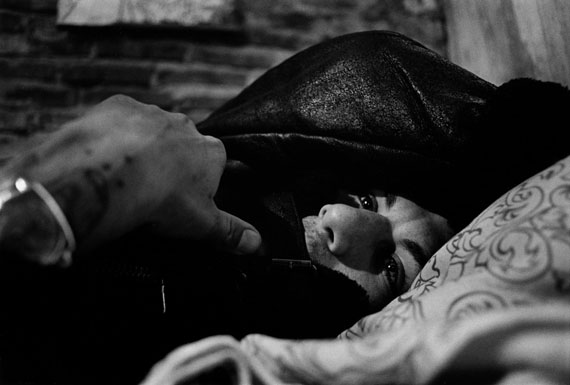
Papucho, 2002-2010
Gelatin silver print
Ed. of 9
40.00 x 30.00 cm
Alfredo Srur »
HERIDAS
Exhibition: 1 Oct – 29 Oct 2016
Fri 30 Sep 19:00

Galerie Julian Sander
Bonner Str. 82
50677 Köln
+49 (0)221-170 50 70
galerie@galeriejuliansander.de
www.galeriejuliansander.de
Wed-Fri 10-18, Sat 12-16 + b.a.

Camila, Carlos’ niece, 2003
Gelatin silver print
Ed. of 9
40.00 x 30.00 cm
Alfredo Srur
"Heridas"
Exhibition: 1 – 29 October 2016
Opening: Friday, September 30, 7pm
Curator's Tour: Saturday, Oktober 1, 3pm
Book Presentation: Friday, Oktober 28, 7pm
Artist's Tour / Finissage: Saturday, Oktober 29, 5/6pm
As part of the EMOP Berlin - European Month of Photography 2016
The photo series "Heridas" by the Argentinien photographer Alfredo Srur will be displayed for the very first time in Europe as part of EMOP Berlin - the European Month of Photography 2016, and further at Galerie Julian Sander in Cologne, opening on October 22.
Latin America is often described as one of the most violent regions in the world. Reasons for criminality and violence are complex, yet the urban areas characterized by their lack of law and order are specifically prone to eruptions of violence — from the bottom up and top down. The same is true for San Fernando, a district on the outskirts of Buenos Aires. In 2002, Srur was invited by a human rights activist to visit the neighborhood of San Fernando, 30 km away from the city center. There, on February 6th 1999, a 17 years old boy was murdered by the police inside his house. The kid was known as "El Frente Vital", and he was praised for being an outlaw that turned his awareness of social justice into action by helping the poor.
Driven by a mix of curiosity and fascination, Srur spent the next eight years of his life investigating what’s been so alien to him, the social codes and dynamics of the neighborhood. There he met Carlos, a gang leader and >Vital’s< best friend. Carlos is the protagonist of this series, is the photographer’s alter ego. He invited Srur to become part of his world and to experience life through his eyes. Srur’s photographs explore the complex reality of people living on the edge of society, in an attempt to demystify the common assumptions about marginality. "Heridas" is the result of an encounter between two sides of Argentinian society that were never supposed to come together. >Heridas< questions the clichés of living on the edge of society. With an outstanding sense for composition and light, Alfredo Srur tells a story of broken toys, broken dreams and tenderness that pervades the shadows of shanty town.
Alfredo Srur was born in Buenos Aires in 1977. He studied film production at the University of California, where he first came into contact with photography. He attended a photography workshop held by Jorge Saenz from 1999 to 2001 and has been studying at Eduardo Gil’s Photographic Aesthetics Workshop in 2005. For 16 years he has been developing documentary projects in Colombia, Honduras, Ecuador, Argentina and Peru. In 2013 he acquired the photographic archive of Harry Grant Olds, one of the most important photographers working in Latin America in the beginning of the 20th Century. Two years later he founded the Centro de Investigación Fotográfico Histórico Argentino (Cifha) in his hometown Buenos Aires where Srur lives and works. �

Mary, Carlos’ mother, 2002-2010
Gelatin silver print
Ed. of 5
50.00 x 60.00 cm
Alfredo Srur
"Heridas"
Ausstellung: 1. Oktober bis 29. Oktober 2016
Eröffnung: Freitag, 30. September, 19 Uhr
Kuratorenführung: Samstag, 1. Oktober, 15 Uhr
Buchpräsentation: Freitag, 28. Oktober, 19 Uhr
Künstlerführung und Finissage: Samstag, 29. Oktober, 17/18 Uhr
Im Rahmen der EMOP Berlin – European Month of Photography 2016
Die Fotoserie "Heridas" des argentinischen Fotografen Alfredo Srur wird erstmals in Europa zur EMOP Berlin – European Month of Photography 2016 gezeigt und ist ab dem 22. Oktober in der Galerie Julian Sander, Köln, zu sehen sein.
Lateinamerika wird oft als eine der gewaltsamsten Regionen der Welt beschrieben. Die Ursachen für Kriminalität und Gewalt sind komplex, doch die von Regellosigkeit geprägten Stadtgebiete sind besonders anfällig für Gewaltausbräche – von oben wie von unten. Dieses Szenario gilt auch für San Fernando, einen Stadtteil am Rand von Buenos Aires, dreißig Kilometer vom Stadtzentrum entfernt. Alfredo Srur wurde 2002 von einem Menschenrechtsaktivisten eingeladen, San Fernando zu besuchen. Dort ermordete die Polizei am 6. Februar 1999 einen 17jährigen Jungen. Der Junge war bekannt als "El Frente Vital", ein Outlaw, der sich für soziale Gerechtigkeit einsetzte, um den Armen zu helfen.
Angetrieben von einer Mischung aus Neugier und Faszination entschied sich Alfredo Srur, die kommenden 8 Jahre in einer ihm vollkommen fremden Kultur zu verbringen, um die sozialen Kodizes und Verhaltensweisen dieser Gemeinschaft zu verstehen. Srur lernte Carlos, Anführer einer Gang und "Vitals" besten Freund, kennen. Carlos ist der Protagonist von Srurs fotografischer Serie, das Alter Ego des Fotografen. Er lud Srur ein, Teil seiner Welt zu werden und diese durch seine Augen zu sehen. Srurs Fotografien untersuchen die komplexe Realität von Menschen, die am Rande der Gesellschaft leben, in einem Versuch, die allgemeinen Annahmen über Marginalität zu entmystifizieren. "Heridas" ist das Resultat einer Begegnung von zwei Seiten der argentinischen Gesellschaft, die eigentlich nie zusammentreffen sollten. "Heridas" stellt Klischees über Randexistenz in Frage. Mit seinem ungewöhnlichen Blick für Komposition und Licht erzählt Srur eine Geschichte äber kaputtes Spielzeug, zerbrochene Träume und die Zärtlichkeit, die die Schatten der Barackensiedlung durchdringt.
Alfredo Srur wurde 1977 in Buenos Aires geboren. Er studierte Filmproduktion an der Universität von Kalifornien, wo er zum ersten Mal mit Fotografie in Berührung kam. 1999 bis 2001 besuchte er den Fotografie-Workshop von Jorge Saenz. 2005 nahm Srur am ›Photographic Aesthetics Workshop‹ (TEF – Talleres de Estética Fotográfica) von Eduardo Gil teil. Alfredo Srur entwickelt seit 2000 dokumentarische Projekte in Kolumbien, Honduras, Ecuador, Argentinien und Peru. Im Jahr 2013 erwarb er das Fotoarchiv von Harry Grants Olds, einer der bedeutendsten Fotografen in Lateinamerika zu Beginn des 20. Jahrhunderts. Zwei Jahre später gründete er das Centro de Investigación Fotográfico Histórico Argentino (Cifha) in seiner Heimatstadt Buenos Aires, wo Srur lebt und arbeitet.�

Carlitos Early Morning, 2002-2010
Gelatin silver print
Ed. of 9
40.00 x 30.00 cm

Sabina’s house, 2002-2010
Gelatin silver print
Ed. of 9
40.00 x 30.00 cm
